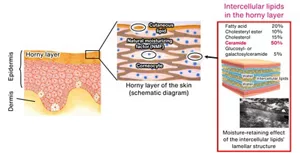Understanding the Skin Science of Sensitive Dry Skin and Developing Ceramide Formulations to Treat It
Moisture Retention Care
The outermost layer of the skin, called the stratum corneum, acts as a barrier preventing foreign substances from entering the body and works to keep the skin moist. If these functions deteriorate, the skin loses moisture and turns into sensitive dry skin, which is vulnerable to problems caused by external irritations. Lipid molecules located between the cells of the stratum corneum (corneocytes), composed mainly of ceramide, play an important role in the stratum corneum’s functions. In healthy skin, the intercellular lipids form a lamellar structure and fill up the space between the corneocytes, so the layer can retain water to keep the skin moist and fulfill its function as barrier.
Ceramide molecules are easy to arrange in a certain orientation, but these molecules are prone to crystallizing and forming deposits. This becomes problematic when ceramide is used in formulations because it interferes with their proper functioning. At Kao, our goal is to develop compound formulations that contain functional ceramide and use these compounds in moisture-retention products which maintain skin moisture at normal levels. We have already successfully analyzed the mechanism controlling crystallization with physicochemical methods, and have developed a technology to control lipid association and induce the formation of a lamellar structure.
To efficiently deliver the functional ceramide molecules to the stratum corneum, we developed a technique to dispense the ceramide molecules as fine emulsions in which they retain their lamellar structure. In doing so, we demonstrated that the high moisture-retention and barrier-support effects of this new ceramide formulation could improve symptoms of skin irritation in sensitive dry skin*1 .
Through the cooperation of various research and development departments and in collaboration with academia and other external partners, Kao has shed light on the condition of sensitive dry skin at the molecular level and has discovered new techniques for making skin care formulations. We will apply this knowledge to developing products for healthy and beautiful skin.
-
* 1 Dermatol., 32, 18〜27, 2022

Lamellar structure of lipids located between cells of the stratum corneum and the mechanism of moisture retention in the skin

Improvement of the penetration rate into the skin of fine emulsion lipid formulation while retaining the lamellar structure
Related Information
- Home
- Innovation
- Research & Development
- Product Development Research
- Skin Care
- Understanding the Skin Science of Sensitive Dry Skin and Developing Ceramide Formulations to Treat It
- Home
- Innovation
- Research & Development
- Product Development Research
- Skin Care
- Understanding the Skin Science of Sensitive Dry Skin and Developing Ceramide Formulations to Treat It
